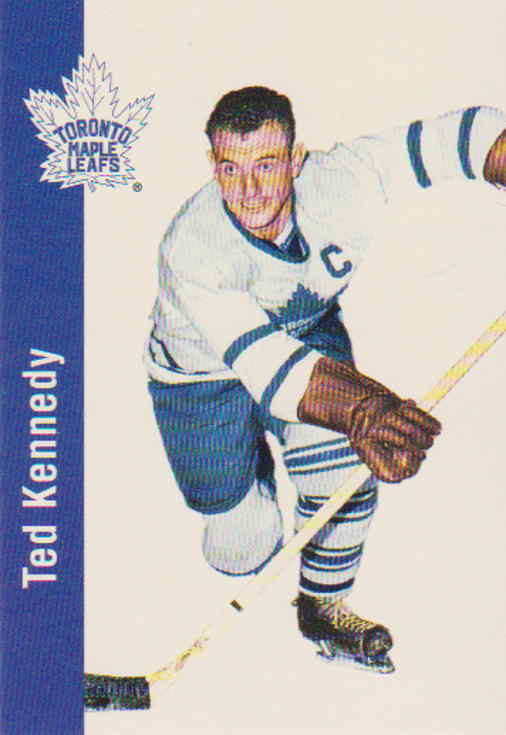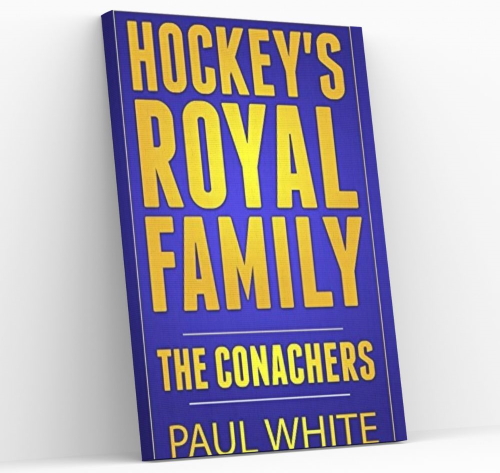"Teeder" Kennedy:
Leafs Legend
Teeder" Kennedy a Leafs Legend was almost a member of the Montreal Canadiens but a homesick 16 year-old changed that by leaving Canadiens training camp for home.
|
Theodore S. “Teeder” Kennedy was born on December 12, 1925, in Humberstone, Ontario, now a part of the city of Port Colborne. How Kennedy became known as “Teeder” is not quite clear. In a Legends of Hockey article, Kennedy related that his Christian name was Theodore and that as a child this had proved to be a difficult name for his young friends to say, and somehow, they mispronounced it as “Teeder”. |
 Ted "Teeder" Kennedy - Paul White Hockey Card Collection Ted "Teeder" Kennedy - Paul White Hockey Card Collection |
At the age of 16, the Montreal Canadiens signed Kennedy to a contract. But when he attended his first training camp with the Canadiens, “Teeder” became so homesick, he packed up his gear and left training camp abruptly.
Back at home, he played amateur hockey. It was here that he came to the attention of former NHL scoring great, Nels Stewart, who was coaching Port Colborne’s senior team. Stewart was to have a deep impact on the young player. Kennedy recalled, “Nels taught me how to operate in front of the net … something basic — take a long look before you shoot the puck. Don’t rush. Coming from Nels, I never forgot the lessons.” He learned quickly from Stewart. During his season with the Port Colborne Sailors, Kennedy scored 23 goals in 23 games and added an impressive 29 assists.
Recognizing a potentially great hockey player, Stewart told Frank Selke, then-acting general manager of the Maple Leafs, of Kennedy’s capabilities. Selke responded by arranging a trade with Montreal.
Conn Smythe, the Maple Leafs owner, provided some interesting insight into the Frank Eddolls-for-Kennedy trade in his memoirs, Conn Smythe: If You Can’t Beat ‘Em In The Alley. Smythe recalled, “I was furious about not even being consulted. Eddolls had joined the Air Force soon after signing with us, and I thought trading him was a stinking trick to play on a man who was going overseas.” Smythe’s attitude toward the trading of Eddolls is understandable, because he was very loyal to players who gave up the game to enlist during the war.
Selke acted as general manager of the Leafs while Smythe himself was overseas with the Canadian armed forces during World War II. He suspected his relationship with Smythe was in trouble because he had not notified the owner of the impending trade.
When Smythe returned from the war, his relationship with Selke cooled. Some suggest that Smythe feared the Kennedy trade signalled the beginning of a power shift in the Leaf’s management offices, and that ultimately, he would find himself "on the outside, looking in” at Selke and others running the team he had built. Selke ultimately moved on to Montreal. There, he made a significant contribution to creating the Canadiens teams that would dominate the NHL for many years.
“Teeder” began playing for the Leafs at the age of 18. During his twelve-season career with Toronto they won five Stanley Cup championships. Kennedy’s hard work and dedication to his team and to hockey. In his last season, 1954-55, he was awarded the Hart Trophy as the league’s MVP. Conn Smythe said that he could have watched Kennedy play forever because he worked so hard.
He may not have been the best skater, but Smythe was right. Kennedy was known throughout the league as one of the best defensive centres in the game as well as perhaps the premier face-off man in the business.
The 1943-44 season was Kennedy’s first full campaign with the Leafs. In his second season his scoring prowess came to the fore as he led the club to a surprise Stanley Cup victory over the Canadiens. Kennedy was the goal-scoring leader in that successful playoff run. In 1946, Kennedy was teamed with Howie Meeker and Vic Lynn on a line that was dubbed the “KLM Line.” This line led the Maple Leafs to three Stanley Cup victories in 1947, 1948 and 1949. This combination of players certainly seemed to benefit Kennedy, who led the team in scoring with 28 goals and 32 assists.
Syl Apps retired at the end of the 1948 season and Kennedy was named to replace him as captain. Conn Smythe suggested that although the loss of Apps was hard on the club, it may have been even tougher on Kennedy. The Leafs owner always felt that after Apps left the team, Kennedy tried too hard to fill the void created by the former captain’s departure. But even if there was some basis for Smythe’s concerns, Kennedy continued to be a stellar performer for many more years.
If there was a low point in Teeder Kennedy’s career, it probably occurred in the first game of the 1949-50 playoff series against the Detroit Red Wings. At 8:41 of the third period, Gordie Howe attempted to check Kennedy and instead crashed into the boards. The Red Wings’ star, near death, lay crumpled on the ice. He had suffered a fractured skull, a broken nose, a broken collarbone and a scratched eye. Seeing their teammate lying on the ice in a pool of blood, the incensed Red Wings attacked Kennedy. Soon players from both teams were battling on the ice. Leaf’s coach Hap Day managed to get Kennedy off the ice, but the rough play continued. Even after the game, Detroit players vowed to “get Kennedy” for what they described as his vicious attack by the Leaf player on Howe.
With the passage of time cooler heads prevailed and the Red Wings relaxed their attempts to exact retribution on Teeder. In the February 1969 edition of Hockey Illustrated, Sid Abel recalled the incident. “It was kind of a chippy game that night,” recalled Abel. “Everybody was taking a run at one another. I thought Gordie got a butt end. Later I felt sorry for Kennedy. He got the brunt of it from all angles — players and fans.”
In a 1975 interview with author Jack Batten, "Teeder" recalled the incident from his perspective. The referee, George Gravel, had his hand up to signal a charging penalty to Howe, when the Detroit star missed Kennedy and crashed into the boards. He claimed that everybody saw this, including Clarence Campbell, who “was sitting right there and saw everything, the president of the league.”
Kennedy went on to explain why, despite all this evidence, the Detroit players and fans continued to blame him for Howe’s injuries. He claimed that Red Wings’ general manager, Jack Adams, “was from the old school of letting your emotions run away, and stirred up a fuss, blaming me for Howe’s injury”. Everybody listened to these accusations because, “James Norris, Sr., the old man, was still alive then. He was very influential. He owned the Red Wings, owned most of Chicago, and had some ownership of Madison Square Garden, so when he made waves, you felt water all over the league. At any rate, the guys on our team were very upset over the criticism of me. It took a lot of starch out of us.”
Perhaps it was the injury to Howe that inspired the Red Wings, or it was intimidation exacted upon Kennedy and the other Leafs, or a combination of both. But the Wings defeated the Leafs in the semi-final, ending Toronto’s three-season Stanley Cup winning streak. Detroit then went on to capture the Stanley Cup “for their injured teammate.”
It was "Teeder" who made a key play to set up Bill Barilko’s overtime goal in the 1950-51 Stanley Cup playoffs. Barilko was the most unlikely of hockey scoring heroes, and his goal is forever cemented in the memories of NHL fans by the fact that he disappeared that same summer while on a fishing expedition in the northern Ontario barrens. Had it not been for a key play by "Teeder" Kennedy, Barilko might never have scored that famous goal.
In August 1951 J.P. Bickell, one of Conn Smythe’s long-time business associates, passed away. Bickell had been a key contributor to the quick and efficient building of Maple Leaf Gardens during the depression years, and also an important member of the Maple Leafs management team. To honour this great hockey entrepreneur the Maple Leafs established a trophy in his name. The Bickell Trophy recognizes great contributions to the Toronto Maple Leafs hockey club. This trophy is not an annual award. Instead, it can be given out at the discretion of the Board of Directors — for one tremendous feat, for a season of spectacular play, or for remarkable long-term service. The first player to be so recognized, and the trophy’s first recipient, was "Teeder" Kennedy in 1953. Only a select few in the long and storied history of the Toronto Maple Leafs have been honoured to join Kennedy as Bickell Trophy recipients.
In 1966 "Teeder" Kennedy was inducted into the Hockey Hall of Fame. Ironically, this was the same year that his teammate Max Bentley was named to the Hall of Fame. And on October 3, 1993, the Toronto Maple Leafs once again recognized the phenomenal contributions of "Teeder" Kennedy when they hoisted a banner bearing his image and his #9 jersey to the rafters of Maple Leaf Gardens.
In August 2014, the Toronto Maple Leafs bestowed another honour on "Teeder" Kennedy when they selected him first of all the Leafs legends to Legends Row.
|
This article is a shortened version of the chapter on "Teeder" Kennedy in my 2006 book, Great Centremen: Stars of Hockey's Golden Age, Altitude Publishing. |
Great Centremen: Stars of Hockey's Golden Age
|
More Great Hockey History Stories
Syl Apps: A Maple Leafs Icon whose smooth skating HHoF talents make him one of the greatest All-Time hockey players in the history of the NHL. Ironically, before he became a Maple Leaf one NHL general manager decided not to sign him to a contract solely because Apps had aspirations of becoming a minister!
Jean Beliveau, an outstanding hockey player, baseball player, a nice guy who in Quebec City was known as the "Ice Cream Man".
Tommy Burlington: the Greatest North American Never to Play in the NHL captured scoring titles in every league that he played, bringing comparisons to NHL greats.
Alex Faulkner: NHL Pioneer only played one game as a Toronto Maple Leaf, but to hockey fans in Newfoundland it was an important hockey game!
Forbes Kennedy suited up for 13 regular season games and one playoff game as a Toronto Maple Leaf. But a lot can happen in 14 hockey games!
Ted "Teeder" Kennedy a Leafs Legend was almost a member of the Montreal Canadiens but a homesick 16 year-old changed that by leaving Canadiens training camp for home.
Hockey history: Florida details the one-year life of the Tropical Hockey League that entertained fans in the south Florida region in the late 1930s.
Larry Jeffrey started his career as a Red Wing, won a Stanley Cup with Toronto, had a short stint as a Ranger and then retired to the beach in Goderich, Ontario!
Rocket Richard, Montreal Canadiens superstar sniper was a goal-scoring nightmare for goalies especially for one NHL goaltender in particular.
Paul Henderson: A Canadian Hockey Hero, "I scored six really good goals and the garbage goal is the one that everyone remembers.”
W.O.A.A. - Western Ontario Athletic Association was the idea of one man that grew to successfully promote sports in western Ontario.
Hockey history is full of surprises, amazing stories and athletes who never cease to surprise. It is more than just stories about the NHL, it is tales from the minor leagues, the bush leagues, and much more. And, it is not just a Canadian story.






